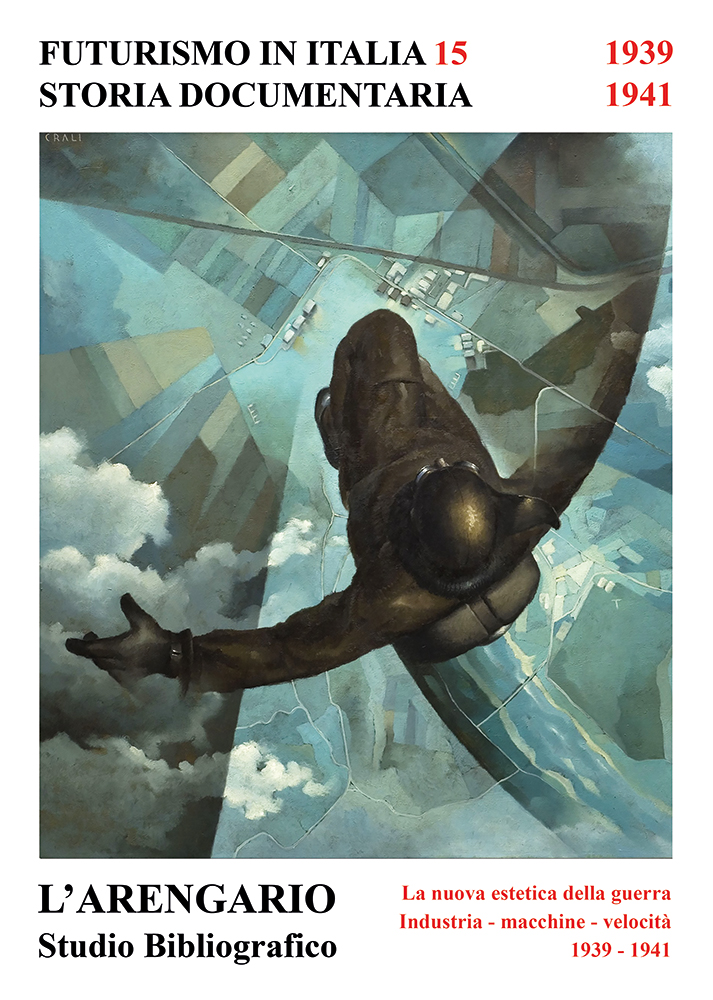L'ARENGARIO STUDIO BIBLIOGRAFICO - Dott. Paolo Tonini
Futurismo in Italia - 15. La nuova estetica della guerra. Industria macchine velocità (1939 - 1941)
Luogo: Cellatica
Editore: L'Arengario Studio Bibliografico, "Storia Documentaria del Futurismo in Italia - 15"
Stampatore: prodotto in proprio
Anno: 2024 (25 settembre)
Legatura: brossura
Dimensioni: 29,7x21 cm.
Pagine: pp. VIII - 112 (4) compresa la copertina
Descrizione: copertina illustrata con la riproduzione del dipinto di Tullio Crali «Prima che si apra il paracadute» (1939). Catalogo interamente illustrato a colori, 112 schede ragionate, a cura e con testo introduttivo di Paolo Tonini («La nuova estetica della guerra: allora e ora» / «The New Aesthetic of War: then and now»). Edizione digitale.
Bibliografia: N. D.
Prezzo: N. D.ORDINA / ORDER
"La trasfigurazione lirica non era che l’atto di adesione alla realtà dei fatti, all’orrore della storia. Ma
in quella adesione, più o meno entusiastica e cosciente, si consumava una disperata affermazione di sé: il senso del tragico, sapere che solo nell’essere disposti a morire è il senso del vivere: guerra sola igiene del mondo. Confrontiamo gli entusiasmi di allora e quelli che ora si contrappongono nel gioco delle parti, in Africa e in Europa. L’orrore è lo stesso, nel nome di Dio, dello Stato, della Patria, ma nessun lirismo ne tempera la volgarità. Dove sono, che fanno oggi gli artisti, i poeti? La guerra è la principale risorsa di un sistema economico che per continuare a esistere deve periodicamente distruggere quello che ha sovraprodotto. E questo avviene nell’indifferenza di chi è lontano da quei conflitti, in ameni dibattiti, nei consessi internazionali e nelle trattative in cui si esibiscono personaggi farseschi, nello spettacolo che deve continuare, senza coscienza, senza rimorsi, senza vergogna" (dal testo introduttivo).
"The lyrical transfiguration was nothing more than an act of adherence to the reality of events, to the horror of history. But in that adherence, more or less enthusiastic and conscious, a desperate affirmation of self was consumed: the sense of tragic, knowing that only in being willing to die lies the meaning of living: war, sole hygiene of the world. Let us compare the enthusiasms of yesterday with those of today opposing each other in the play of roles, in Africa and Europe. The horror is the same, in the name of God, of State,of Homeland, but no lyricism tempers its vulgarity. Where are the artists, the poets now? War is the main resource of an economic system that, to continue existing, must periodically destroy what it has overproduced. And this happens amidst the indifference of those far from those conflicts, in pleasant debates, in international assemblies, and in negotiations where farcical figures parade, in the spectacle that must go on, without conscience, without remorse, without shame".
DOWNLOAD PDF FILE
"The lyrical transfiguration was nothing more than an act of adherence to the reality of events, to the horror of history. But in that adherence, more or less enthusiastic and conscious, a desperate affirmation of self was consumed: the sense of tragic, knowing that only in being willing to die lies the meaning of living: war, sole hygiene of the world. Let us compare the enthusiasms of yesterday with those of today opposing each other in the play of roles, in Africa and Europe. The horror is the same, in the name of God, of State,of Homeland, but no lyricism tempers its vulgarity. Where are the artists, the poets now? War is the main resource of an economic system that, to continue existing, must periodically destroy what it has overproduced. And this happens amidst the indifference of those far from those conflicts, in pleasant debates, in international assemblies, and in negotiations where farcical figures parade, in the spectacle that must go on, without conscience, without remorse, without shame".
DOWNLOAD PDF FILE

